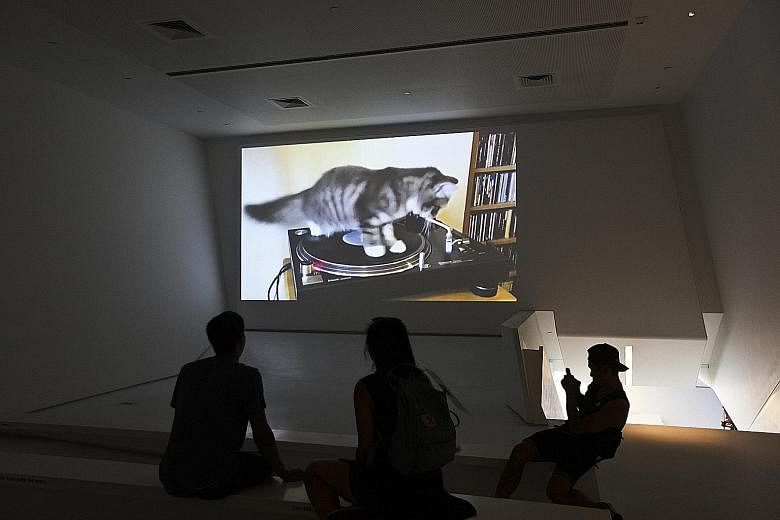NEW YORK • While it is not true that 15 per cent of all Internet traffic is cat-related, as a cat food company asserted in 2013, that makes a convincing urban legend.
"For some reason, cats took off and then it's this avalanche that just sort of keeps piling up," said Mr Jason Eppink, curator of How Cats Took Over The Internet, an exhibition that opened last Friday at the Museum of the Moving Image.
"People on the Web are more likely to post a cat than another animal because it sort of perpetuates itself. It becomes a self-fulfilling prophesy."
The exhibition - which may be the first mainstream museum installation entirely dedicated to cats online - is made up mostly of images, videos and GIFs of cats and is meant to be a cultural deconstruction of their enduring popularity.
The show takes a high-minded look at anthropomorphism and what it calls the "aesthetics of cuteness" as well as a low-brow wallow through cheesy trends - such as the LOLcats who demand cheezburger - and bad puns, such as Caturday, a fad that had people posting cat pictures on Saturdays.
The cornerstone of the exhibition is a 20-year timeline that traces the history of cats on the Internet to 1995, when a news group - a bulletin board-type online community that was an early form of social media - coalesced around the members' love of cats.
From this began Meowchat, where people swopped role- playing messages posing as their cats, talking in a sort of baby talk.
The part of the timeline dealing with the present serves as a nostalgia gallery for anyone who has squandered the workday on popular share-mails: There is Cliche Kitty, a frolicking kitten in a field of dandelions that is blithely unaware it is being menaced from behind; Grumpy Cat (of course); and Nyan cat, a cartoon image of a cat named for the Japanese term for "meow".
There are homages to cat shaming, in which people photograph their cats next to confessional signs ("I puked on my owner's chair"); cat breading, where cat owners place actual slices of bread around their hapless pet's face and take a picture; and - in an up-to-the-moment cultural reference - Trump Your Cat, which involves brushing the cat and forming the loose fur into a Donald Trump-style toupee on its head.
"Even as far back as 1991, 1995, there was a whole community of cat lovers who found one another online and was doing creative things," said Mr Eppink, 31, who does not own a cat. "They were being performative and creative."
The exhibition reaches back even further, showing what cat video historians believe was the very first example of the genre: a Kinetoscope shot by Thomas Edison in 1894 of two cats in a boxing ring sparring with gloves.
Mr Carl Goodman, the museum's executive director, said the Museum of the Moving Image - in an arts district next to Kaufman Astoria Studios, a film production hub - tends to be known for whatever exhibition it is showing, which right now is one about the TV show Mad Men.
Every year, the museum hosts an independent video game festival called IndieCade. It is now installing a permanent gallery dedicated to Jim Henson, creator of the Muppets.
Mr Goodman, who said he "happened to own" a Labradoodle, was enthusiastic about the Internet cat exhibition from the start, but acknowledged there would be doubters. "Some people are going to sneer at this - they tend to trivialise cats. By putting this in a museum, we're not saying that it's art, we're not saying that it's not art - we're saying it's culturally significant."
The museum is not the first to present cat videos in this context.
Since 2012, the Walker Art Center in Minneapolis has hosted an annual Internet Cat Video Festival, a sort of Rocky Horror Picture Show for cat lovers, a travelling reel of videos that is screened around the country and updated each year.
The Walker has lent a hand here too: One area of the Astoria exhibition, which occupies a pleasant, open space on the second floor of the white-walled and starkly modern museum, is a screening room with bench seating where a half-hour reel of cat videos will be shown in a continuous loop.
The reel was compiled by Mr Will Braden, curator of the cat video festival for the Walker.
Hardcore cat people will recognise him as the creator of Henri, Le Chat Noir, a world-weary house cat who thinks existential thoughts in French.
In related events, the Museum of the Moving Image will hold a Cat-vant Garde Film Show on Oct 10, showing avant-garde movies such as Nightcats (1956) by Stan Brakhage. People can adopt cats at the museum that day and on a second date to be announced.
Mr Eppink conducted extensive research on the intersection of cats and the Internet.
From New Zealand researcher Radha O'Meara, he learnt why cat videos are perceived as more appealing than dog videos: Because dogs are pack animals that look artlessly into the camera, whereas cats are hunters that do not care if they are being filmed.
"Cats are more mercurial and liminal," he said.
He also crunched numbers with editors from Reddit, YouTube, Tumblr, BuzzFeed and Instagram to suss out what percentage of their traffic was cat-related. Surprise: Other than on Tumblr - where cats are more popular than dogs - cats and dogs tend to be tagged, posted and electronically doted on in equal amounts, seldom exceeding 0.3 per cent of a site's traffic.
"I take delight in finding depth in seemingly frivolous subjects," Mr Eppink said.
NEW YORK TIMES


